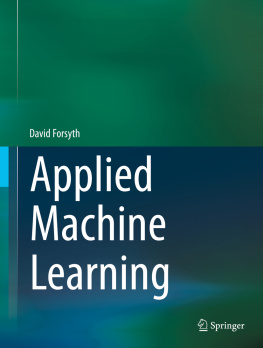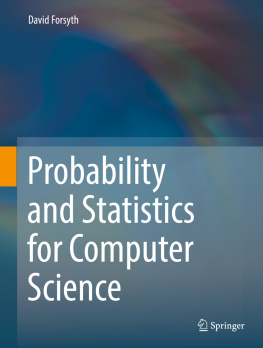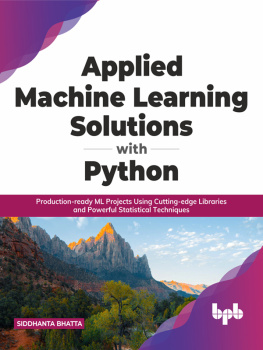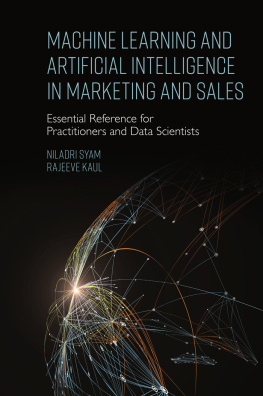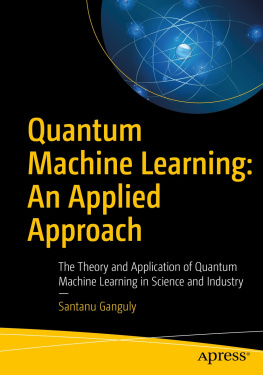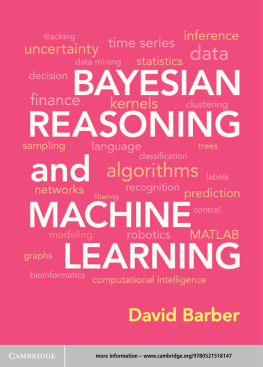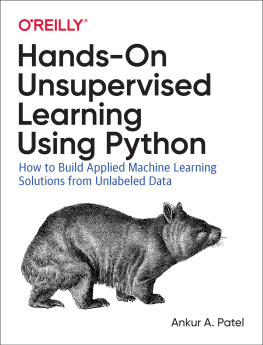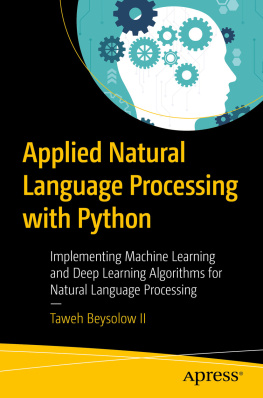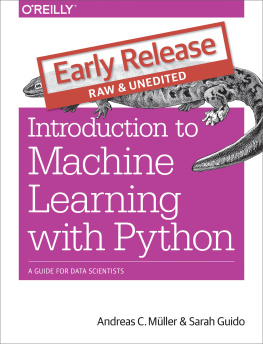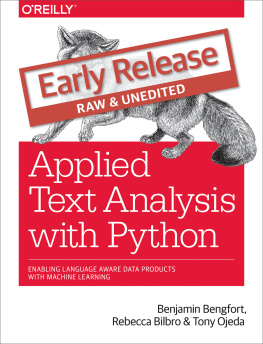David Forsyth - Applied Machine Learning
Here you can read online David Forsyth - Applied Machine Learning full text of the book (entire story) in english for free. Download pdf and epub, get meaning, cover and reviews about this ebook. publisher: Springer International Publishing, genre: Home and family. Description of the work, (preface) as well as reviews are available. Best literature library LitArk.com created for fans of good reading and offers a wide selection of genres:
Romance novel
Science fiction
Adventure
Detective
Science
History
Home and family
Prose
Art
Politics
Computer
Non-fiction
Religion
Business
Children
Humor
Choose a favorite category and find really read worthwhile books. Enjoy immersion in the world of imagination, feel the emotions of the characters or learn something new for yourself, make an fascinating discovery.
- Book:Applied Machine Learning
- Author:
- Publisher:Springer International Publishing
- Genre:
- Rating:3 / 5
- Favourites:Add to favourites
- Your mark:
- 60
- 1
- 2
- 3
- 4
- 5
Applied Machine Learning: summary, description and annotation
We offer to read an annotation, description, summary or preface (depends on what the author of the book "Applied Machine Learning" wrote himself). If you haven't found the necessary information about the book — write in the comments, we will try to find it.
Applied Machine Learning — read online for free the complete book (whole text) full work
Below is the text of the book, divided by pages. System saving the place of the last page read, allows you to conveniently read the book "Applied Machine Learning" online for free, without having to search again every time where you left off. Put a bookmark, and you can go to the page where you finished reading at any time.
Font size:
Interval:
Bookmark:
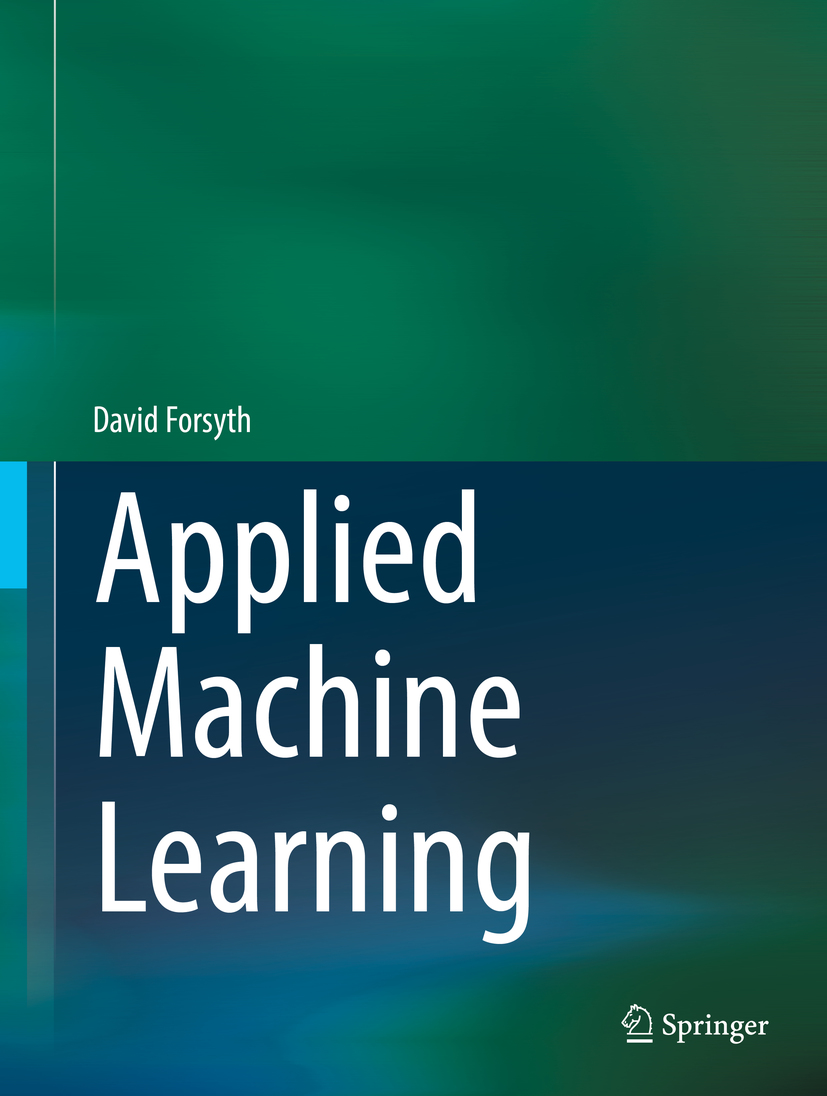

This Springer imprint is published by the registered company Springer Nature Switzerland AG.
The registered company address is: Gewerbestrasse 11, 6330 Cham, Switzerland
Machine learning methods are now an important tool for scientists, researchers, engineers, and students in a wide range of areas. Many years ago, one could publish papers introducing (say) classifiers to one of the many fields that hadnt heard of them. Now, you need to know what a classifier is to get started in most fields. This book is written for people who want to adopt and use the main tools of machine learning but arent necessarily going to want to be machine learning researchersas of writing, this seems like almost everyone. There is no new fact about machine learning here, but the selection of topics is my own. I think its different from what one sees in other books.
The book is revised and corrected from class notes written for a course Ive taught on numerous occasions to very broad audiences. Most students were at the final year undergraduate/first year graduate student level in a US university. About half of each class consisted of students who werent computer science students but still needed a background in learning methods. The course stressed applying a wide range of methods to real datasets, and the book does so, too.
The key principle in choosing what to write about was to cover the ideas in machine learning that I thought everyone who was going to use learning tools should have seen, whatever their chosen specialty or career. Although its never a good thing to be ignorant of anything, an author must choose. Most people will find a broad shallow grasp of this field more useful than a deep and narrow grasp, so this book is broad, and coverage of many areas is shallow. I think thats fine, because my purpose is to ensure that all have seen enough to know that, say, firing up a classification package will make many problems go away. So Ive covered enough to get you started and to get you to realize that its worth knowing more.
The notes I wrote have been useful to more experienced students as well. In my experience, many learned some or all of this material without realizing how useful it was and then forgot it. If this happened to you, I hope the book is a stimulus to your memory. You really should have a grasp of all of this material. You might need to know more, but you certainly shouldnt know less.
I wrote this book to be taught, or read, by starting at the beginning and proceeding to the end. In a 15-week semester, I cover a lot and usually set 12 assignments, always programming assignments. Different instructors or readers may have different needs, and so I sketch some pointers to what can be omitted below.
Various descriptive statistics (mean, standard deviation, variance) and visualization methods for 1D datasets
Scatter plots, correlation, and prediction for 2D datasets
A little discrete probability
A very little continuous probability (rough grasp of probability density functions and how to interpret them)
Random variables and expectations
A little about samples and populations
Maximum likelihood
Simple Bayesian inference
A selection of facts about an assortment of useful probability distributions, or where to look them up
General Background : Your linear algebra should be reasonably fluent at a practical level. Fairly soon, we will see matrices, vectors, orthonormal matrices, eigenvalues, eigenvectors, and the singular value decomposition. All of these ideas will be used without too much comment.
Programming Background : You should be able to pick up a practical grasp of a programming environment without too much fuss. I use either R or MATLAB for this sort of thing, depending on how reliable I think a particular package is. You should, too. In some places, its a good idea to use Python.
Survival Skills : Most simple questions about programming can be answered by searching. I usually use a web search to supply details of syntax, particular packages, etc. which I forget easily. You should, too. When someone asks me, say, how do I write a loop in R? in office hours, I very often answer by searching for R loop (or whatever) and then pointing out that Im not actually needed. The questioner is often embarrassed at this point. You could save everyone trouble and embarrassment by cutting out the middleman in this transaction.
I think using real datasets is an important feature of this book. But real life is messy, and datasets I refer to here may have been moved by the time you read this. Generally, a little poking around using a web search engine will find datasets or items that have been moved. I will also try to provide pointers to missing or moved datasets on a webpage which will also depend from my home page. Its easy to find me on the Internet by searching for my name, and ignoring the soap opera star (thats really not me).
Generally, I have followed the natural style of a textbook and tried not to cite papers in the text. Im not up to providing a complete bibliography of modern machine learning and didnt want to provide an incomplete one. However, I have mentioned papers in some places and have done so when it seemed very important for users to be aware of the paper or when I was using a dataset whose compilers asked for a citation. I will try to correct errors or omissions in citation on a webpage, which will depend from my home page.
Font size:
Interval:
Bookmark:
Similar books «Applied Machine Learning»
Look at similar books to Applied Machine Learning. We have selected literature similar in name and meaning in the hope of providing readers with more options to find new, interesting, not yet read works.
Discussion, reviews of the book Applied Machine Learning and just readers' own opinions. Leave your comments, write what you think about the work, its meaning or the main characters. Specify what exactly you liked and what you didn't like, and why you think so.

